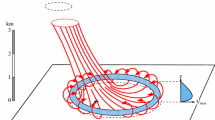Abstract
Despite decades of regulatory efforts in the United States to decrease vulnerability in developed coastal zones, exposure of residential assets to hurricane damage is increasing — even in places where hurricanes have struck before. Comparing plan-view footprints of individual residential buildings before and long after major hurricane strikes, we find a systematic pattern of ‘building back bigger’ among renovated and new properties.


Similar content being viewed by others
Data availability
Study data are available through Figshare (https://doi.org/10.6084/m9.figshare.7108763). Coordinates for the start and end points of the sampled areas are shown in Supplementary Table 4.
References
Moser, S. C. et al. in Climate Change Impacts in the United States: The Third National Climate Assessment (eds Melillo, J. M. et al.) 579–618 (US Global Change Research Program, Washington DC, 2014).
US National Research Council Reducing Coastal Risks on the East and Gulf Coasts (NRC, Washington DC, 2014).
Bagstad, K. J., Stapleton, K. & D’Agostino, J. R. Ecol. Econ. 63, 285–298 (2007).
McNamara, D. E., Gopalakrishnan, S., Smith, M. D. & Murray, A. B. PLoS ONE 10, e0121278 (2015).
Armstrong, S. B. et al. Earths Futur. 4, 626–635 (2016).
Dash, N., Morrow, B. H., Mainster, J. & Cunningham, L. Nat. Hazards Rev. 8, 13–21 (2007).
Peacock, W. G., Van Zandt, S., Zhang, Y. & Highfield, W. E. J. Am. Plann. Assoc. 80, 356–371 (2014).
Highfield, W. E., Peacock, W. G. & Van Zandt, S. J. Plann. Educ. Res. 34, 287–300 (2014).
van Verseveld, H. C. W., van Dongeren, A. R., Plant, N. G., Jäger, W. S. & den Heijer, C. Coast. Eng. 103, 1–14 (2015).
Platt, R. H., Salvesen, D. & Baldwin, G. H. II Coast. Manage. 30, 249–269 (2002).
Deyle, R. E., Chapin, T. S. & Baker, E. J. J. Am. Plann. Assoc. 74, 349–370 (2008).
Dyckman, C. S. & Wood, I. L. Coast. Manage. 41, 501–536 (2013).
Dehring, C. A. & Halek, M. Land Econ. 89, 597–613 (2013).
Hallstrom, D. G. & Smith, V. K. J. Environ. Econ. Manage. 50, 541–561 (2005).
Nordstrom, K. F. & Jackson, N. L. J. Coast. Conserv. 1, 51–62 (1995).
Kim, K. & Olshansky, R. B. J. Am. Plann. Assoc. 80, 289–292 (2014).
Comerio, M. C. J. Contingencies Crisis Manag. 5, 166–178 (1997).
Alexandre, P. M. et al. Int. J. Wildland Fire 24, 138–149 (2015).
Mileti, D. Disasters By Design (Joseph Henry, Washington DC, 1999).
Filatova, T. Environ. Sci. Policy 37, 227–242 (2014).
Acknowledgements
This work was supported in part by the Cardiff Undergraduate Research Opportunities Programme (to E.D.L. and R.D.), and by the UK NERC BLUEcoast project (to E.D.L.; NE/N015665/2). We thank R. C. Ballinger and P. Barnard.
Competing interests
The authors declare no competing interests.
Author information
Authors and Affiliations
Contributions
PWL conceived the idea; all authors contributed to data collection; E.D.L., P.W.L., E.B.G., and R.D. conducted the analysis; E.D.L., E.B.G., and P.W.L. wrote the manuscript, with contributions from R.D. and S.B.A.
Corresponding author
Additional information
Publisher’s note: Springer Nature remains neutral with regard to jurisdictional claims in published maps and institutional affiliations.
Supplementary information
Supplementary Information
Supplementary Methods, Supplementary Reference 1, Supplementary Figure 1, Supplementary Tables 1–4
Rights and permissions
About this article
Cite this article
Lazarus, E.D., Limber, P.W., Goldstein, E.B. et al. Building back bigger in hurricane strike zones. Nat Sustain 1, 759–762 (2018). https://doi.org/10.1038/s41893-018-0185-y
Received:
Accepted:
Published:
Issue Date:
DOI: https://doi.org/10.1038/s41893-018-0185-y
- Springer Nature Limited
This article is cited by
-
Policy and market forces delay real estate price declines on the US coast
Nature Communications (2024)
-
Habitability of low-lying socio-ecological systems under a changing climate
Climatic Change (2024)
-
Demonstrating the value of beaches for adaptation to future coastal flood risk
Nature Communications (2023)





